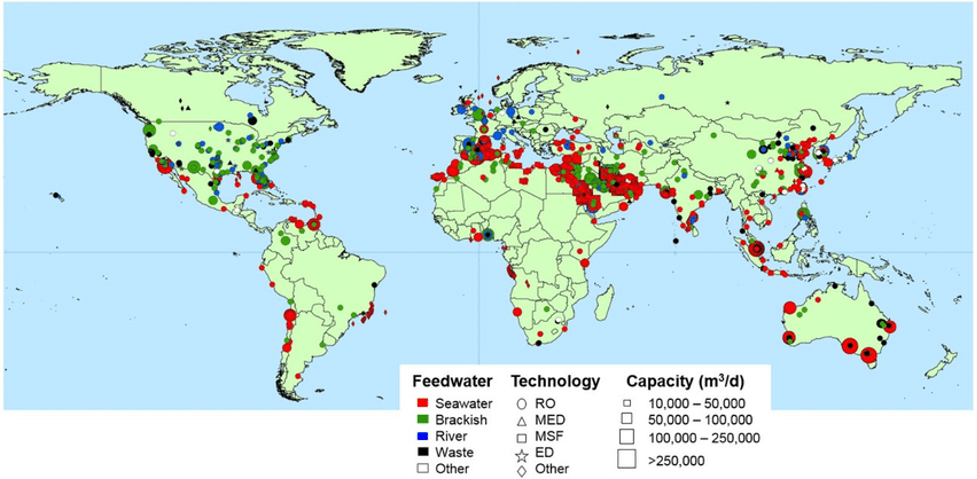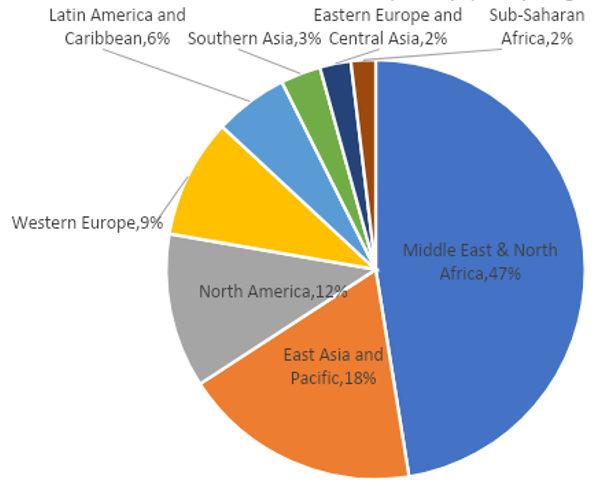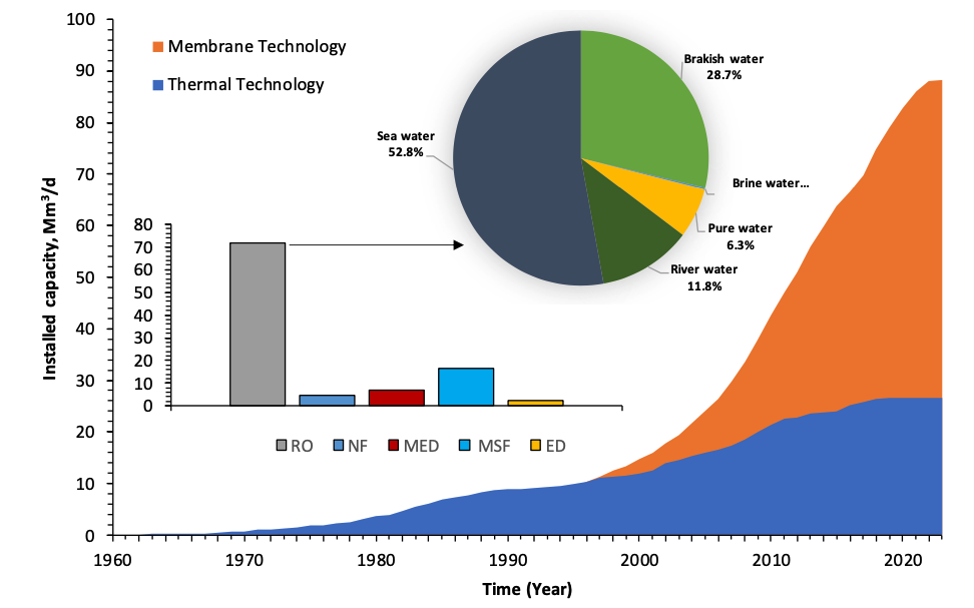Globally, nearly 2 billion people – about half of them in sub-Saharan Africa – lack access to safe drinking water. Water demand has increased by more than double the rate of population growth in the past century.1 The United Nations Environment Program estimates that by 2030, we could face a 40% shortfall in water supply if no drastic changes are implemented in water resources management. In fact, one-third of the world’s aquifers are in distress, mainly due to excessive withdrawals and changing rainfall patterns due to climate change. Averting major water shortages in vulnerable areas will require developing sustainable and energy-efficient ways of producing and managing water resources. Desalinated seawater is an unconventional water resource that can play a key role in achieving SDG6 and alleviating water poverty in coastal countries. However, desalination technologies are energy-intensive, so as the uptake of desalination expands globally, so will energy demand. This could be a major barrier in energy-constrained countries.
FIGURE 1: Global distribution of desalination plants disaggregated by feedwater quality and desalination technology

Source: Curto D, Franzitta V, Guercio A. A Review of the Water Desalination Technologies. Applied Sciences. 20212
Technology and Market Overview
Desalination plants remove salt from seawater using either a thermal process, such as multi-stage flash (MSF) and multi-effect distillation (MED), or a membrane process, such as reverse osmosis (RO), where seawater is pumped through a semi-permeable membrane. The outputs of this process are freshwater which has nearly zero salinity, and brine (a concentrated salt stream). MSF, MED, and RO are the most commercially mature technologies to date.
Desalination can require both thermal and electric energy, which in many areas means it will have significant energy-related emissions. Furthermore, the brine produced from desalination plants, unless properly treated, has harmful effects on marine life. Table 1 compares the dominant technologies in terms of energy demand, emissions, and water cost.3,4,5
TABLE 1: Comparison of thermal and membrane-based desalination technologies3,4,5
| Thermal energy consumption (kWh/m3) | Electric energy consumption (kWh/m3) | Total equivalent mechanical energy consumption (kWh/m3) | Emissions (kg CO2 eq./m3) | Average cost of desalinated water ($/m3) | |
|---|---|---|---|---|---|
| Multi-stage flash (MSF) | 120 | 4 | 20 | 15.6 – 25 | 1.44 |
| Multi-effect distillation (MED) | 80 | 1.5 – 2.5 | 19 | 7 – 17.6 | 1.39 |
| Reverse Osmosis (RO) | – | 5 | 5 | 1.7 – 2.8 | 0.98 – 1.82 |
Currently, there are over 18,000 desalination plants in more than 150 countries supplying around 87 Mm3 (million cubic meters) of fresh water to over 300 million people every day.5 Desalination plays an integral role in the supply of freshwater to the Middle East, where nearly half of global desalination capacity is located, and the biggest markets in the Middle East are Saudi Arabia, the United Arab Emirates, Kuwait, Qatar, and Israel. Desalination is largely deployed in wealthy, energy rich areas of the world, like the United States, Australia, China, Europe, and Japan. But the next growth centers for the technology will be in rapidly growing countries in Africa and Asia such as Senegal, the Philippines, India, Morocco, and South Africa.5,6
FIGURE 2: Global desalination capacity (% by region)7

RO technology dominates the global desalination market and accounts for 77% of the total global volume of desalinated water (around 88Mm3/day). This percentage is expected to increase because of the lower energy consumption and operational costs in RO plants as compared to thermal processes. The global trend to adopt RO has been driven by rapid innovations in membrane materials, energy recovery systems, and plant configurations. Figure 2 shows the evolution and current status of thermal and membrane-based desalination technologies.
FIGURE 3:Evolution and current status of desalination technologies6

How desalination projects are developed
Large-scale desalination plants are often co-generation plants that produce both freshwater and power, and are developed through the independent water and power producer (IWPP) model, where a private developer finances, constructs, and operates the plant for a period of time (20+ years) and then the plant’s ownership is transferred to the off-taker (typically the public utility). This model is also referred to as BOOT (build-own-operate-transfer). During the operation period, the IWPP sells the plant’s water production to the off-taker under a power and water purchase agreement (PWPA), often backed by government guarantees. The IWPP model is the most popular one in the Middle East region since it allows the project to be financed off the balance sheet of the public utility or the equivalent off-taker, and IWPP contracts are usually awarded after a competitive bidding process, where the developer with the lowest levelized cost of water (or power) is selected as the winning bidder. Other models for desalination project development include the Engineering, Procurement, and Construction (EPC) model and the Design-Build-Operate model.
Innovations
The global desalination market has witnessed several innovations in technology, plant configurations, and project financing which have all resulted in lower water production costs, reduced environmental impacts, and lower project risks. In thermal desalination, innovations in feedwater pretreatment through membrane nanofiltration, development of large-capacity evaporators, and advanced evaporator designs are expected to reduce costs by 10-15%.5 However, massive improvements in thermal desalination are unlikely to happen globally, as utilities and developers prefer the more energy-efficient RO technology. RO systems don’t require thermal energy to operate, so are more easily used with direct input from renewable energy and have more than doubled in efficiency over the last 20 years. Innovations such as nanostructured membranes, carbon nanotubes, and new generations of energy recovery devices, are projected to further increase productivity and bring down energy costs by over 30%, and other innovations could bring total water production costs down by nearly 60% through 2030.8 It may be possible to recover valuable rare earth elements from brine, adding additional benefits to RO desalination. Furthermore, there is growing interest in integrating small-scale RO desalination units with solar energy for modular applications in developing countries.
Challenges
While desalination technology is well positioned to play a key role in alleviating water poverty in many developing countries, there are still many challenges that need technological innovation and regulatory support.
- Energy demand and efficiency. Despite technological advancements in recent years, energy consumption still accounts for one-third to one-half of the total costs of desalination. The IEA estimates that by 2040, 15% of the total final energy consumption in the Middle East region will be in desalination.9 It is essential that we accelerate research on technological innovation in energy recovery devices, high-pressure pumps, and evaporator design to reduce the energy required for desalination. Moreover, hybrid desalination configurations and the integration of renewable energy with desalination both present numerous opportunities to enhance the environmental sustainability of this technology.
- Financing. Project financing is one of the main challenges for mega-scale desalination plants, especially in emerging markets. Global experiences have shown that well-designed financing packages and regulatory support (through government guarantees) can lower costs by as much as one-third, even while using conventional technologies. In Israel, the government provided guarantees to developers for changes in interest rates and also covered the costs of land acquisition; thus helping achieve record low bid prices for projects.5
- Environmental impacts. Desalination projects pose serious energy and non-energy-related environmental impacts, which require strong regulatory oversight and technological innovations, especially regarding brine disposal.
Looking ahead, desalination technology, especially RO, will continue to be a major source of fresh water for many Middle Eastern countries. For many developing countries in Asia and Africa, desalination should be considered a candidate technology for providing freshwater for municipal and industrial uses. Technological innovations and regulatory support are the main drivers for addressing desalination’s biggest challenges, namely energy demand and efficiency, financing, and environmental impacts.
Endnotes
- United Nations Economic and Social Council. Progress towards the Sustainable Development Goals – Report of the Secretary-General. 2021. https://documents-dds-ny.un.org/doc/UNDOC/GEN/N21/109/71/PDF/N2110971.pdf?OpenElement
- Curto D, Franzitta V, Guercio A. A Review of the Water Desalination Technologies. Applied Sciences. 2021; 11(2):670. https://doi.org/10.3390/app11020670
- M. Alhaj and S. G. Al-Ghamdi, “Integrating concentrated solar power with seawater desalination technologies: a multi-regional environmental assessment,” Environ. Res. Lett., 2019. http://iopscience.iop.org/10.1088/1748-9326/ab1d74
- M. Wakil, M. Burhan, L. Ang, and K. Choon, “Energy-water-environment nexus underpinning future desalination sustainability,” Desalination, vol. 413, pp. 52–64, 2017. http://dx.doi.org/10.1016/j.desal.2017.03.009
- World Bank. 2019. “The Role of Desalination in an Increasingly Water-Scarce World.” World Bank, Washington, DC. https://openknowledge.worldbank.org/handle/10986/31416
- Salinas-Rodriguez, S.G.; Hamdani, J.; Abushaban, A.; Sawalha, H.; Schippers, J.C.; Kennedy, M.D. Is Desalination a Solution to Freshwater Scarcity in Developing Countries? Membranes 2022, 12, 381. https://doi.org/10.3390/membranes12040381
- E. Jones, M. Qadir, M. T. H. van Vliet, V. Smakhtin, and S. Kang, “The state of desalination and brine production: A global outlook,” Sci. Total Environ., vol. 657, pp. 1343–1356, Mar. 2019. https://linkinghub.elsevier.com/retrieve/pii/S0048969718349167
- A. Al Amoudi and N. Voutchkov. Innovation in Desalination – The Path Forward. 2021. https://idadesal.org/innovation-in-desalination-the-path-forward/
- Molly Walton, “Desalinated water affects the energy equation in the Middle East”. IEA Commentary. 2019. https://www.iea.org/commentaries/desalinated-water-affects-the-energy-equation-in-the-middle-east
